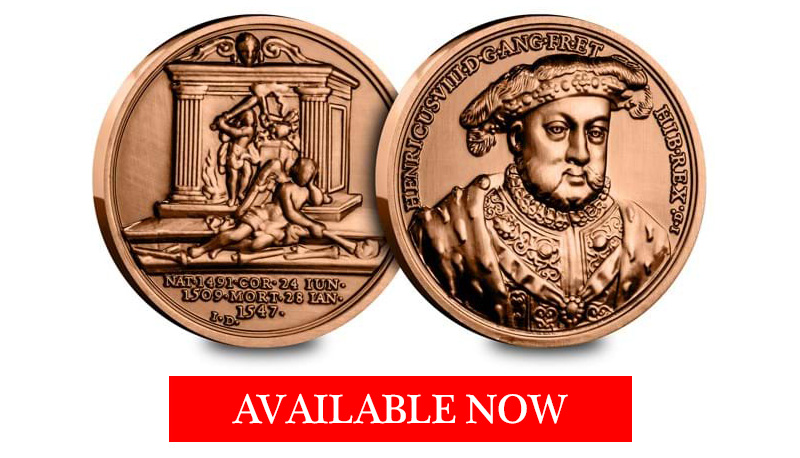The Dassier coins worth THOUSANDS – Your Replica for JUST £4.99
Imagine holding a meticulously crafted medal inspired by the legendary work of Swiss medallist Jean Dassier, celebrating one of England’s most iconic monarchs, Henry VIII. This carefully recreated piece brings a touch of history right into your collection.

Who was Jean Dassier?

Jean Dassier was a master engraver and artist from Geneva, known for his intricate and highly respected medal collections. His career reached new heights in 1731 when he was commissioned to create the “Kings and Queens of England” series.
This original 34-piece series, approved by Queen Caroline, brought the history of British royalty to life in stunning damascened bronze. Each medal portrayed a British Monarch on the obverse and their final resting place on the reverse, showcasing Dassier’s commitment to detail and artistic precision. Dassier’s original works, now almost 300 years old, are coveted pieces that sell for thousands of pounds at The Royal Mint.

Now, you can pay tribute to Dassier’s genius with an exacting recreation of the Henry VIII medal, available to you for only £4.99 (+p&p) when you trial the Dassier Replica Collection.
This piece captures the intricacies of Dassier’s original design, offering a chance to connect with history and celebrate the legacy of one of England’s most famous rulers. Crafted to mirror Dassier’s vision, this medal is as much a piece of art as it is a collectible, allowing you to experience the grandeur of the “Kings and Queens of England” series.
This is a unique opportunity to own a piece of historical artistry inspired by the originals Dassier poured his skill into nearly three centuries ago. Each medal in this series preserves the royal legacy Dassier set out to capture, making it a must-have for history enthusiasts, collectors, and admirers of fine craftsmanship alike.
Secure your Jean Dassier Henry VIII Medal today for the introductory offer price of JUST £4.99 (+p&p). and start your collection with this timeless tribute.
But, with just 9,995 available worldwide, time is of the essence…
Click here to claim yours before it’s too late >>
How You Can Own Australia’s FIRST EVER King Charles III Coinage

The Royal Australian Mint have unveiled their official effigy of His Majesty King Charles III, over 2 years since the Queens’s passing, this has been highly anticipated as one of the final Commonwealth Nations to change their effigy.


As the very first set to feature the Australian effigy of King Charles III, there has been great demand from collectors wanting to secure their own piece of numismatic history.
Each set has made the 10,000-mile journey from Canberra to here in the UK, so we only have a limited number available – even as an official distributor for The Royal Australian Mint.


Available in either the Brilliant Uncirculated or Proof quality, you can choose how you wish to mark this historic occasion. Both specifications are free of any marks or blemishes and feature all six denominations, from the 5-cent piece to the 2-dollar coin.
Protectively housed in a specially designed display case to preserve your Australian coinage for generations to come.
Our Top Christmas Collectables
As the holiday season approaches, there’s no better time to explore our carefully curated selection of Christmas collectables, perfect for adding some festive cheer to your collection or finding the ideal gift for a loved one. Let’s take a look at some of the top Christmas collectables that are sure to bring joy this season.

BRAND-NEW: The 2024 Christmas Nativity Ten Pence Collection
Celebrate the Nativity in style with the 2024 Christmas Nativity 10p Coins, beautifully designed by renowned artist Garry Walton. Each coin features a vibrant, stained-glass window-inspired design that brings the Nativity story to life. With a Brilliant Uncirculated Quality and selective colour printing, this collection is a stunning reflection of one of the most beloved stories of the season.
Not only are these coins officially approved by King Charles III and Buckingham Palace, but they also come with a Certificate of Authenticity and a bespoke Presentation Case. With an initial price of £15, followed by interest-free instalments, this collection offers affordability along with the prestige of owning a limited-edition Christmas treasure. The 2023 collection sold out quickly, so secure yours today to avoid disappointment!
BRAND NEW Official Peter Pan Brilliant Uncirculated 50p Set
Add a touch of magic to your Christmas with the enchanting Peter Pan 50p Set, celebrating 120 years since the first performance of the classic tale in 1904. With five beautifully designed coins by David Lawrence, this set features beloved characters such as Peter Pan, Captain Hook, and the Lost Boys, all in stunning Brilliant Uncirculated Quality.
Best of all, this set isn’t just a magical keepsake—it’s issued in support of Great Ormond Street Hospital Charity. With 10% of proceeds donated to the charity, you’re not only adding to your collection but also making a real difference in the lives of children and families at GOSH. Join collectors in raising funds and owning a piece of Peter Pan history today.
The One with the Silver 1oz FRIENDS Commemorative
If you’re a fan of FRIENDS, this 1oz Pure Silver Commemorative is the perfect way to commemorate the iconic sitcom that first aired almost 30 years ago. Featuring a colorised picture of the cast on the reverse and the famous water fountain on the obverse, this limited-edition coin is a must-have for fans of the series. With only 995 available, this collectable won’t be there for long, so act fast to secure a piece of TV history for your collection.
LIMITED EDITION: Christmas Snowmen Colour BU 50p Set
Nothing says Christmas like snowmen, and this charming set of five 50p coins is the perfect way to get into the festive spirit. Each coin features a delightful snowman scene brought to life with selective colour printing. Struck to Brilliant Uncirculated Quality, these coins are presented in a special Christmas tin, making them an ideal festive gift or a special treat for yourself.
With an edition limit of just 1,495 sets, these coins are in high demand and will disappear faster than Santa on Christmas Eve. Don’t miss out on the opportunity to spread the cost with five interest-free instalments of £15, and add a little extra magic to your collection this Christmas.
2024 UK Star Wars™ Spacecraft BU 50p Pack
The Force is strong with this one! In partnership with the Walt Disney Company and Lucasfilm, The Royal Mint has released a series of 50p coins celebrating some of the most iconic spacecraft from the Star Wars™ universe. Featuring the Millennium Falcon, X-Wing, TIE Fighter, and Death Star II, each coin includes a lenticular feature that reveals Star Wars™ symbols when tilted.
This is the perfect gift for both Star Wars™ fans and coin collectors alike. Plus, you’ll save over 15% when purchasing the complete collection as a pack, preserving it for lightyears to come. Demand is high, so make sure you secure yours before they’re all gone!
Add Some Festive Cheer to Your Collection
Whether you’re adding to your personal collection or looking for the perfect gift, these must-have collectables will bring a little extra magic to your holiday season. Don’t wait—these limited-edition items are sure to sell out quickly, so secure your favourites today!









